|
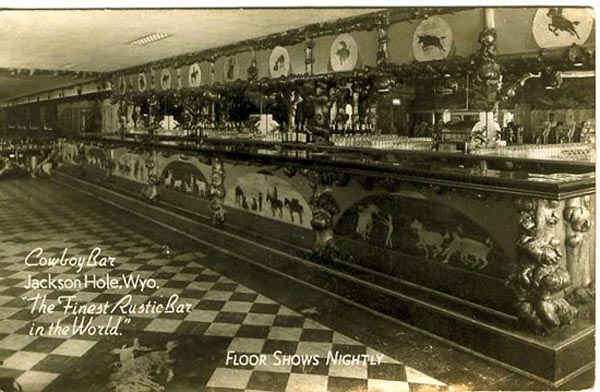
Bar, Cowboy Bar, 1950's. On the right hand side of the photo, slot machines are clearly visible in the mirror. See closeup next photo.
In Wyoming, just about every town has a "cowboy bar." Only Jackson has a "Million Dollar Cowboy Bar." The bar has over the years changed from one which actually appealed to
cowboys to one which appeals to tourists. As James Brooke, a writer for the New York Times,
August 14, 1996, put it: "While Jackson's 19 gift shops, 21 clothing stores and 33 art galleries relentlessly
peddle variations on the cowboy theme, the closest that most visitors come to a cowboy is
the buckaroo on the Wyoming license plate of their rental car."
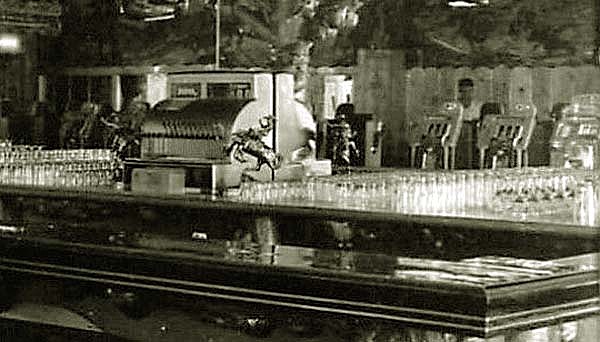
Closeup backbar mirror, 1950's.
Gambling in Wyoming has been illegal since 1901. Gambling remained in Teton County throughout the
1930's and later. As indicated by
the above and next photos, slot machines were very much in the open in the Cowboy Bar until 1956 when Governor Milward
Simpson finally had enough of the flouting of the law in Teton County. The slot machines were immediately to the
left as one entered the saloon, directly across from the bar.
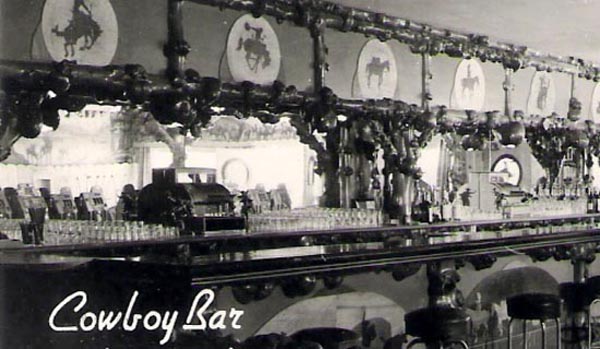
Backbar mirror Cowboy Bar, 1950's. On either side of the cash register, slot machines are clearly visible in the mirror.
The bar allegedly has at least one bullet hole in it, not, however, from any
Old West shoot-out. Supposedly, a night watchman, Cyrus Ray Ferrin, was scared by either his
own shadow or the shadow of his pet poodle. Ferrin, the brother-in-law of Goe, was originally a stockgrower, but fell on hard
times during the Depression. Thus, he took employment at the Cowboy Bar as night watchman and
occasionally at the gambling tables.
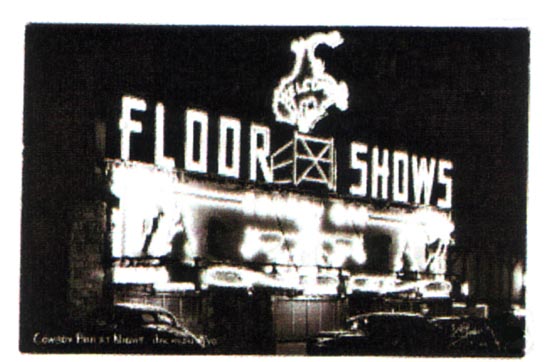
Neon Sign, Cowboy Bar, late 1940's.
The neon lights in the top photo were added by Preston Parkinson after he purchased the bar from Goe about 1945.
Parkinson also added the appellation "Million Dollar" after renovations were required as a result of a gas explosion in the basement.
The term "Floor Shows" does not indicate a Las Vegas type review. It denotes that there is
live music.
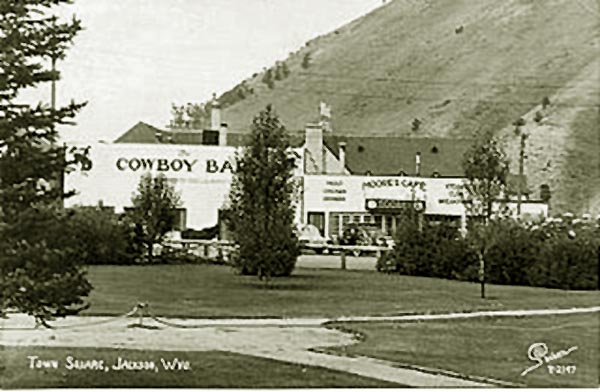
Cowboy Bar, Jackson, approx. 1941.
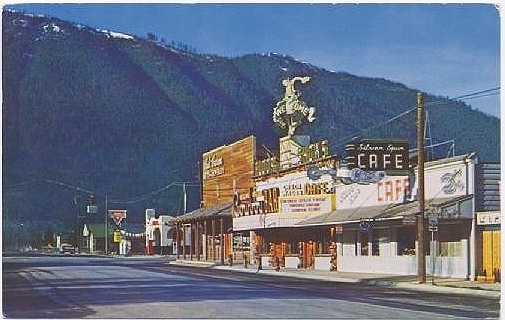
Jackson, Cache looking South to Broadway, approx. 1960.
The Cowboy bar is famous for its elaborately carved bar built by Jack Kranenberg and Nels Elder.
In its top are embedded approximately six-hundred silver dollars.
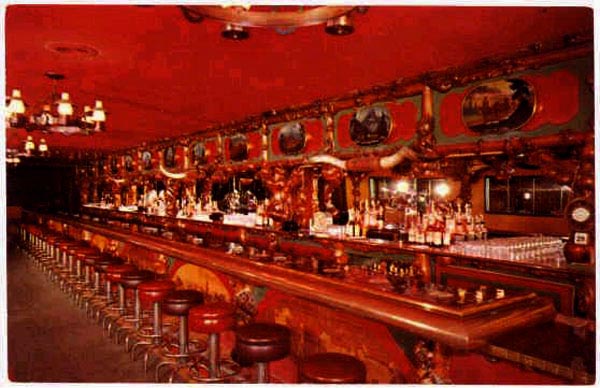
Bar in Cowboy Bar, prior to 1973.
Originally, the bar had
ordinary bar stools. In 1973, the bar stools were replaced by saddles with little saddle blankets.
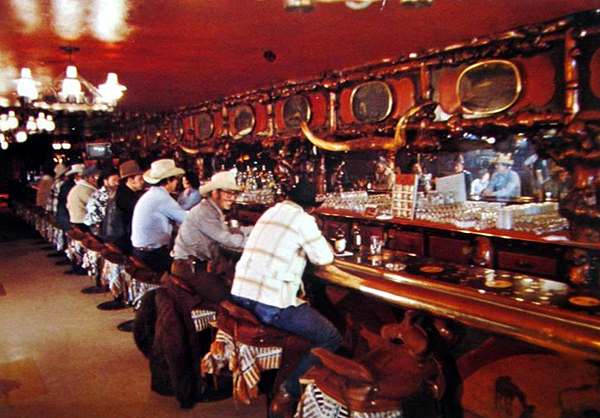
Bar in Cowboy Bar, post 1973.
In 2003 the writer visited the bar.
At that time although the bar still had a few cowboys the majority of patrons rode iron horses from Sturgis. The bar featured various trendy
micro-brewery style bottled beer including Snake River and Moose Drool. On the day in question, however,
they were out of Moose Drool, brewed in Missoula. As of 2013 the Moose Drool was again available. As of May 2022, Moose Drool no longer appeared on the beer
menu.
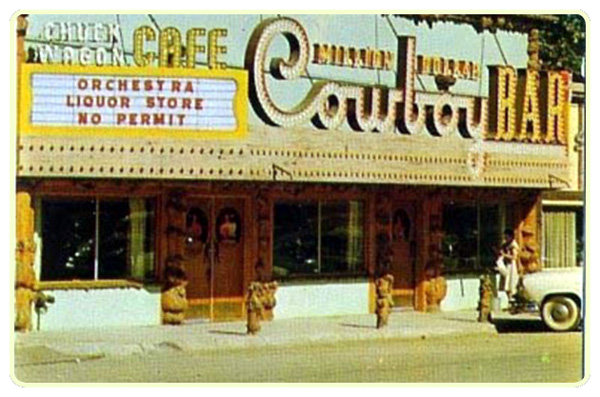
The Front doors of the Cowboy Bar 1950's.
The knobby wood appearance of the bar was carried through to the outside doors of the bar.
Music this page in remembrance of the day the Harley riders from Sturgis drank up all the Moose Drool, a day
similar to that in Australia during World War II when Yank troops stopped by
a pub in Taylor's Arm, Queensland, or perhaps Ingham, New South Wales. The Yank navy
did not permit alcohol on its ships. Needless to say, The Yanks drank whereever they were dry (both towns claim that it was their
pub which inspired the song. Both towns and two separate pubs claim the honour.
A Pub With No Beer
By Gordon Parsons and Slim Dusty
Based on a poem by Dan Sheahan
Performed by Montana Slim (Wilf Carter)
Oh it's-a lonesome away from your kindred and all
By the campfire at night we'll hear the wild dingoes call
But there's-a nothing so lonesome, morbid or drear
Than to stand in the bar of a pub with no beer
Now the publican's anxious for the quota to come
And there's a far away look on the face of the bum
The maid's gone all cranky and the cook's acting queer
Oh what a terrible place is a pub with no beer
Then the stockman rides up with his dry dusty throat
He breasts up to the bar and pulls a wad from his coat
But the smile on his face quickly turns to a sneer
As the barman says sadly the pub's got no beer
Then the swaggie comes in smothered in dust and flies
He throws down his roll and rubs the sweat from his eyes
But when he is told, he says what's this I hear
I've trudged fifty flamin' miles to a pub with no beer
Now there's a dog on the v'randa, for his master he waits
But the boss is inside drinking wine with his mates
He hurries for cover and he cringes in fear
It's no place for a dog 'round a pub with no beer
And old Billy the blacksmith, the first time in his life
Why he's gone home cold sober to his darling wife
He walks in the kitchen, she says you're early Bill dear
But then he breaks down and tells her the pub's got no beer
Oh it's hard to believe that there's customers still
But the money's still tinkling in the old ancient till
The wine buffs are happy and I know they're sincere
When they say they don't care if the pub's got no beer
So it's-a lonesome away from your kindred and all
By the campfire at night we'll hear the wild dingoes call
But there's-a nothing so lonesome, morbid or so drear
Than to stand in the bar of a pub with no beer.
Writer's notes: "Quota," during the war the production of beer was
limited and pubs were rationed. "Swaggie," a hobo who carried his worldly possesson in
his swag, i.e. a sack on the end of a stick. Sheahan was inspired to write his poem,
by entering the pub to find no beer. The drovers within were forced to drink wine.
Several years after the song was recorded for the first time, it was noticed that the
music bears a similarity to Stephen Foster's "Beautiful Dreamer"
|
Next Page: Jackson Continued.
|


|